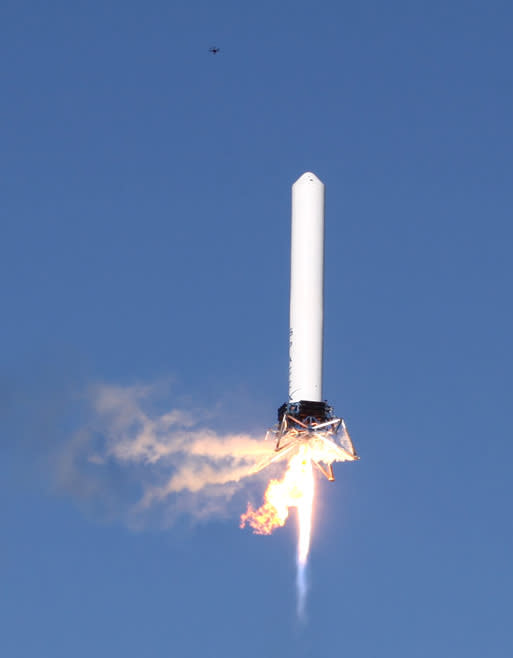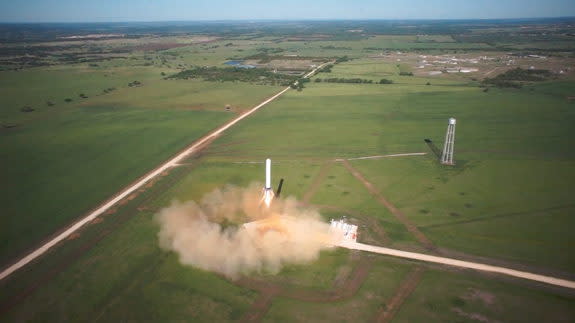Private 'Grasshopper' Rocket Prototype Makes Highest Flight Yet
A private experimental rocket that may eventually lead to a fully reusable launch system has flown higher than ever before, soaring 80 stories into the air before landing softly back at its pad.
The prototype Grasshopper rocket, built by the private spaceflight company SpaceX, flew to an altitude of 820 feet (250 meters), hovered for a brief stretch and then returned to Earth at the company's rocket development facility in McGregor, Texas, on Friday (April 19).
The 1-minute test flight was the fifth made by the Grasshopper rocket. The jaunt more than tripled the rocket's previous record altitude of 263 feet (80 m), which was achieved during a March 7 test flight. [See more photos of SpaceX's novel Grasshopper rocket]
SpaceX shot a stunning video of Grasshopper's April 19 flight, incorporating footage shot from the ground with that taken by a miniature, six-bladed "hexacopter" probe (and setting the whole thing to Johnny Cash's famous song "Ring of Fire").
The hexacopter shots weren't just for dramatic effect.
"We capture footage for our own testing and review needs," David Rosen, SpaceX's senior director of communications, told SPACE.com via email. "This test achieved 820 feet — three times higher than our last benchmark. Aerial was all but required."
SpaceX's Grasshopper rocket stands about 10 stories tall. It incorporates the first-stage tank of SpaceX's Falcon 9 rocket, which launches the company's Dragon capsule on unmanned cargo missions to the International Space Station for NASA. (The company holds a $1.6 billion contract to make 12 such deliveries for the space agency and has already completed two of them).
Grasshopper uses one Merlin engine (compared to nine for the Falcon 9) and lands vertically on four metallic legs. SpaceX is using Grasshopper to test out the technologies needed to develop a fully reusable rocket, which experts say would make spaceflight much cheaper and more efficient.
SpaceX is set to expand these tests beyond Grasshopper soon, Rosen said.
"This year is about hopefully recovering the first stage of Falcon 9 from an ocean landing — we’ll execute an initial recovery attempt(s) with a water landing of the first stage," he said. "As early as next year, with a lot more experience and data, we’ll bring the first stage back to the launch site with the landing gear deployed. It’s important to note that we don’t expect success right off the bat."
Grasshopper's previous four flights took place in September, November, December and March. Those hops reached maximum altitudes of 8.2 feet (2.5 m), 17.7 feet (5.4 m), 131 feet (40 m) and 263 feet (80 m), respectively.
Follow Mike Wall on Twitter @michaeldwall and Google+. Follow us @Spacedotcom, Facebook or Google+. Originally published on SPACE.com.
Copyright 2013 SPACE.com, a TechMediaNetwork company. All rights reserved. This material may not be published, broadcast, rewritten or redistributed.

